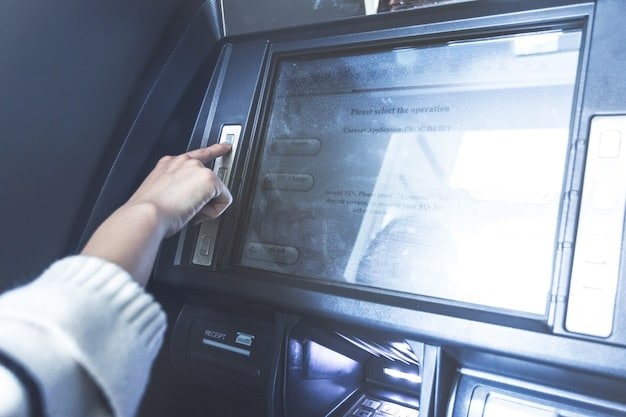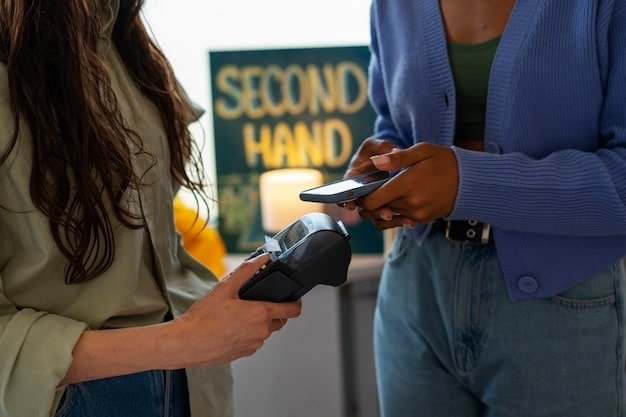Credit Card Skimming in 2025: US Travelers’ Guide to Threats & Prevention

Credit card skimming remains a significant threat in 2025, demanding heightened vigilance from US travelers as criminals evolve their tactics; this guide explores emerging threats, offers proactive prevention strategies, and empowers you to safeguard your financial data while traveling.
The threat of credit card skimming continues to plague US travelers in 2025. As technology advances, so do the tactics of criminals looking to steal your financial information. Staying informed and proactive is crucial to protecting yourself from becoming a victim.
Understanding the Evolving Threat of Credit Card Skimming
Credit card skimming is not a new crime, but its sophistication is constantly evolving. In 2025, travelers face a range of skimming techniques, making it essential to understand these threats to mitigate risks effectively.
Traditional Skimming Methods
Traditional skimming involves attaching a small device to a card reader, such as an ATM or point-of-sale (POS) terminal, to illegally capture card data. These devices are typically difficult to detect.
Emerging Skimming Techniques
Modern skimmers are becoming increasingly sophisticated. Techniques such as shimmer skimming, where a thin device is inserted inside the card reader, are on the rise, making them nearly invisible to the naked eye.
- Bluetooth-Enabled Skimmers: These skimmers transmit stolen data wirelessly, allowing criminals to collect information from a distance.
- NFC Skimming: Some skimmers now exploit near-field communication (NFC) technology to steal data from contactless cards.
- ATM Malware: Hackers are deploying malware that turns ATMs into skimming devices, capturing data and PINs.
Staying aware of these evolving techniques is paramount. Simple visual inspections may no longer be sufficient, requiring more proactive measures.

In conclusion, the landscape of credit card skimming is continuously changing. By understanding both traditional and emerging techniques, travelers can better defend themselves against these threats and protect their financial information.
Key Indicators of Skimming Devices to Watch For
Identifying potential skimming devices requires a keen eye and attention to detail. By recognizing key indicators, travelers can avoid compromised ATMs and POS terminals, protecting their credit card information.
Physical Inspection Tips
Conduct a thorough physical inspection of any card reader before use. Look for irregularities or signs of tampering.
Common Signs of Tampering
Be wary of loose or misaligned card reader components, scratches, or glue residue. These could indicate that a skimming device has been attached.
- Unusual Keypad Overlays: Skimmers often install fake keypads to capture PINs. Check for spongy or ill-fitting keypads.
- Bulky Card Slots: A skimmer attached to the card slot may make it appear larger or protrude noticeably.
- Mismatched Colors or Materials: Skimming devices are often made from different materials or have slight color variations compared to the original machine.
Always trust your instincts. If something feels off or looks suspicious, it’s better to err on the side of caution and find another machine.
In summary, vigilance and careful observation are crucial in detecting skimming devices. By being aware of common signs of tampering, travelers can significantly reduce their risk of falling victim to credit card skimming.
Proactive Prevention Strategies for US Travelers
While vigilance is essential, proactive prevention strategies offer the most robust defense against credit card skimming. Implementing these measures can significantly reduce your vulnerability while traveling.
Utilizing Advanced Security Measures
Take advantage of security features offered by modern banking and credit card services to enhance your protection.
Enabling Real-Time Alerts and Notifications
Set up real-time transaction alerts through your bank or credit card provider to monitor your account activity closely.
- Using Mobile Payment Systems: Opt for mobile payment options like Apple Pay or Google Pay, which use tokenization to protect your card details.
- EMV Chip Cards: Always use the EMV chip reader instead of swiping your card, as chip cards provide an additional layer of security.
- Two-Factor Authentication: Enable two-factor authentication for your online banking and credit card accounts to prevent unauthorized access.

By actively using these security measures, travelers can proactively protect themselves against credit card skimming and unauthorized transactions.
In conclusion, proactive prevention strategies are vital for protecting your credit card information. By utilizing advanced security measures and staying informed, travelers can significantly reduce their risk of becoming victims of skimming.
Best Practices for Secure ATM and POS Terminal Usage
The way you use ATMs and POS terminals can significantly impact your vulnerability to credit card skimming. Following best practices ensures you’re not inadvertently exposing your data.
Choosing Secure ATMs and Terminals
Select ATMs and POS terminals with care, opting for those in secure, well-lit locations to minimize risk.
Safe Usage Guidelines
Follow these guidelines to ensure secure transactions at ATMs and POS terminals, reducing your exposure to skimming threats.
- Covering the Keypad: Always shield the keypad with your hand when entering your PIN to prevent visual capture by hidden cameras.
- Avoiding Standalone ATMs: Use ATMs located inside banks or well-established businesses, as they are generally more secure.
- Reporting Suspicious Findings: If you notice anything suspicious, such as unusual signage or tampering, report it immediately to the bank or store management.
Being selective about where and how you conduct transactions can substantially reduce your risk of encountering skimmers.
In summary, secure ATM and POS terminal usage requires awareness and caution. By choosing trusted locations and following safe transaction practices, travelers can protect their credit card information from skimming threats.
Staying Updated on the Latest Skimming Trends and Alerts
Knowledge is power when it comes to combating credit card skimming. Keeping updated on the latest trends and alerts helps travelers stay one step ahead of criminals.
Reliable Sources of Information
Stay informed by consulting reputable sources that provide timely and accurate information about emerging skimming techniques.
Staying Informed
By leveraging credible sources and actively monitoring alerts, travelers can adapt their prevention strategies to address new skimming threats effectively.
- Bank and Credit Union Alerts: Subscribe to email or SMS alerts from your financial institutions to receive updates on potential security breaches or skimming threats.
- Security Blogs and Websites: Follow reputable cybersecurity blogs and websites that provide in-depth analysis of emerging skimming trends.
- Government and Law Enforcement Agencies: Monitor alerts and advisories from agencies like the FBI and FTC regarding financial scams and skimming schemes.
Regularly educating yourself on the latest skimming trends ensures you are always prepared and vigilant.
In conclusion, staying updated on the latest skimming trends and alerts is essential for proactive protection. By leveraging reliable sources of information, travelers can better defend themselves against evolving skimming threats and safeguard their financial data.
What to Do if You Suspect Your Card Has Been Skimmed
Even with the best prevention strategies, there’s always a chance your card could be compromised. Knowing how to respond quickly can minimize the damage.
Immediate Actions to Take
Take swift action to mitigate the impact of potential skimming. Immediate action is critical to minimize potential financial losses.
- Contact Your Bank or Credit Card Company: Report the suspected skimming incident immediately to your financial institution. They can cancel your card and issue a new one.
- Monitor Your Account Activity: Closely monitor your account statements for any unauthorized transactions. Report any suspicious activity to your bank.
- File a Police Report: Filing a police report can help with any potential insurance claims and may assist law enforcement in tracking down the perpetrators.
Prompt action can prevent criminals from exploiting your compromised card and minimize potential financial losses.
In summary, knowing what to do if you suspect your card has been skimmed is crucial for minimizing financial impact. By taking immediate action to report the incident and monitor your accounts, travelers can protect themselves from further losses.
| Key Point | Brief Description |
|---|---|
| 🛡️ Inspect Card Readers | Look for irregularities before using ATMs and POS terminals. |
| 📱 Use Mobile Payments | Opt for Apple Pay or Google Pay for secure transactions. |
| 🚨 Enable Transaction Alerts | Monitor your account activity with real-time notifications. |
| 📞 Report Suspicious Activity | Contact your bank immediately if you suspect skimming. |
Frequently Asked Questions
▼
▼
▼
▼
▼
Conclusion
As we navigate the evolving landscape of credit card skimming in 2025, it’s clear that vigilance and proactive measures are our best defense. By staying informed, inspecting card readers, using secure payment methods, and promptly reporting suspicious activity, US travelers can significantly reduce their risk of falling victim to this pervasive threat.





